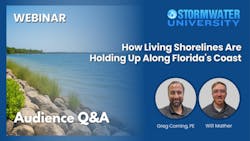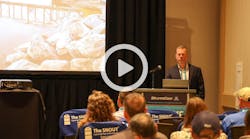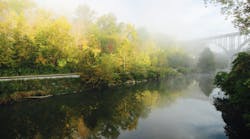Webinar Q&A: How living shorelines are holding up along Florida's coast
In August, Stormwater Solutions hosted a webinar called “How Living Shorelines Are Holding Up Along Florida’s Coast.” The webinar covered coastal erosion Greg Corning and Will Mather from WSP in the U.S., shared lessons learned from their work designing and implementing living shorelines across the state. Using insights gained from last year’s hurricane season, they explored where these nature-based solutions work best, what makes them succeed, and how the design process balances environmental and engineering considerations. Below, read common audience questions from the webinar with answers from the speakers.
To watch the webinar on-demand, click here.
Audience: Did you all notice any impact on the surrounding SAV following construction at the Franklin site?
Speakers: Yes, we have. Seagrass has started to settle behind the reefs and is filling out around the reefs. We have also noted the seagrass encroaching around the outer edges of the reefs. The SAV beds in the project area move around quite a lot to the point that a lot of our surveys are useless after about six months as the beds have shifted. So, we anticipated the seagrass moving closer to the reefs, but it’s really promising to see the seagrasses expanding into the areas behind the reefs.
Audience: How sensitive are the broken concrete breakwaters to any remaining steel rebar or mesh? Does removal need to be 100%?
Speakers: The recycled concrete used for the reefs on Franklin-98 was screened for exposed rebar or wire sticking out of the concrete prior to deployment. Our permits prohibited any exposed metals in the reefs, and we really did not want metal debris in the reefs to begin with. Removal of the metal was not 100% as rebar still existed inside some of the concrete pieces, but we cut it off as close to the concrete as possible. So far, we have not seen any negative effects on concrete reefs.
Audience: How does the community typically respond to these kinds of projects?
Speakers: I cannot speak for all communities, but for the community of Eastpoint, Florida, there was mixed feedback at first. Most of the hesitation was based on not understanding that there was no financial obligation from the private landowners and concerns around impacts on their property. Once their concerns were heard and addressed, most of the community was neutral or slightly positive about the project. Also, since a decent amount of private land in the area was for vacation homes, some of the landowners were difficult to get ahold of. So,when the owners of these vacation homes came down to the area for vacation, they were blindsided by this living shoreline effort and that caused a bit of a negative outlook. Most of the year-round locals were very supportive of the project, and having a local construction contractor helped a lot as they would help answer questions the community had while they were going about their day.
Stakeholder engagement is a critical component of living shorelines projects. Generally, if the stakeholders are informed early and given updates regularly, then they will be supportive of the project for the most part.
Audience: Do you end up with a lot of sedimentation in the areas behind the breakwaters and, if so, is that well received by the adjacent landowners?
Speakers: We did capture a fair amount of sediment behind the reefs, and so far, we have not received any complaints from adjacent landowners. We monitor the reefs and the surrounding areas routinely to see if any issues are appearing so we can adaptatively manage potential problems. A lot of the adjacent landowners actually signed up for the project just after the reefs were built since they could see the system working and better understood what we were building.
Audience: What are the typical maintenance requirements and costs for a living shoreline compared to hard infrastructure?
Speakers: Costs for maintenance will vary based on the site conditions, but generally a living shoreline will require one to two site visits a year to survey the marsh/mangroves, the oyster/coral, and the reef structures. Additionally, if your living shoreline has waterway markers installed, the signage will need to be inspected. This effort generally boils down to <$4-5k a year to send a team out to survey the site, assuming low travel times and no major issues identified. Maintenance for a hard infrastructure is generally the same in terms of effort, but the key difference is that the hard infrastructure has a shelf life. The seawall or bulkhead will eventually fail and need to be replaced or fixed. Additionally, if issued with the hard infrastructure are spotted, the methods to investigate and repair the issues can be more costly due to the need for heavy machinery.
Audience: Will mentioned the difficulty with working around SAVs and the 15-foot requirement. How did you work around that requirement and/or meet exemptions for it to build the breakwaters for the Franklin 98 project?
Speakers: FDEP only requires a 3-foot buffer to seagrass but considering how much SAV was in our project area and how important it is, we asked FDEP to increase the buffer to 15 feet. There were two general approaches we took for planning out the reef outlines on Franklin-98, drone imagery or in-person GPS surveys. For the drone imagery we flew drones at low tide to capture aerial images of the exposed beds and digitized the extents of the beds from the imagery. Then we planned the extents in GIS, and verified prior to construction, making edits to the outline as needed. For the in-person GPS surveys, we sent a team out at low tide (sometimes around 2 a.m.) to measure 15 feet of seagrass they found in the project area and stake out the outline of the reef. Then, we used a Real Time Kinematics GPS unit to log the outline we staked out.
Audience: Are elevated walkways ever erected over living shorelines for public use?
Speakers: Yes, though the walkways would need to allow light to pass through to prevent damage to the plants stabilizing the shoreline. Building a pier along a living shoreline for an educational opportunity sounds like a really good idea, I would love to try to implement something like that in the future.
Audience: Are there living shoreline-type solutions to retain introduced beach sediment threatened by precipitation runoff and erosion?
Speakers: Possibly, if we are talking about a public use beach where there is a lot of foot traffic then a living shoreline might not be the best solution. A vegetated dune system could be implemented to help with runoff erosion, but mitigating the wave energy would be a challenge, as any structures put in the water could pose a hazard to people using the beach.
Audience: Has the wave energy threshold beyond which living shorelines are not recommended been evaluated or quantified?
Speakers: The threshold for wave energy will vary based on site conditions, so there is not a specific number to point out, but generally we can look to wave heights for this answer. Generally, if the shoreline is experiencing waves less than 2 feet, then it is a low wave energy system. If waves are between 2 and 5 feet, then it’s medium, and greater than 5 feet is high energy akin to open ocean conditions. Living shorelines can be designed to suit low and medium conditions, but once you get into high energy areas grayer infrastructure is needed to utilize a living shoreline.
Audience: For areas where there is a long beach area going out to the Gulf, do you find dune areas with grasses are a good protection solution?
Speakers: Yes, dune systems are a great protection solution. Depending on the site's characteristics, some additional protection might be needed, but dunes are a great starting point.


